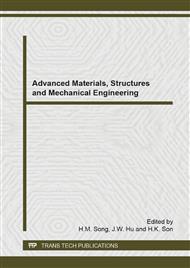p.683
p.688
p.693
p.697
p.703
p.709
p.717
p.723
p.731
The Research of Concrete Sealer Penetrating Depths
Abstract:
It’s quite often that dispensing a topping material like concrete crystalline penetration sealer materials onto the surface of a plastic substance such as concrete to extend its service life span by surface protections from outside breakthrough. When applied to concrete it reacts with calcium hydroxide and reduces the porosity and permeability of the concrete matrix. This serves to increase the hardness and chemical resistance which, in turn, increases the service life span of the surface. A series of tests, such as rapid chloride permeability test, scanning electron microscope, and mercury intrusion porosimetry, were performed on the concrete test samples to examine the durability, by taking the penetration depth of concrete crystalline penetration sealer materials as a characterization parameter describing the durability in relation to water resistance. The penetration depth is a critical property for concrete crystalline penetration sealer materials to function effectively. The deeper the penetration, the greater the thickness of concrete strengthened, thus improving wear resistance, the life span and durability. The desirable depth drawn from tests is about 10mm with a minimum of 5mm. However the regular attainment of such penetration will require considerable care in surface preparation and in assuring that the concrete is properly dry. The quality of the concrete will also be a major factor in the depth of penetration obtained. Penetration depths may be greater with poor quality porous concrete while a 10mm depth may not be possible with high-quality dense concrete. Other Factors affecting concrete sealer penetration depth are related to the process, such as coverage and application, a user who should understand how it works, and material itself, having its own image.
Info:
Periodical:
Pages:
703-708
Citation:
Online since:
September 2014
Authors:
Price:
Сopyright:
© 2014 Trans Tech Publications Ltd. All Rights Reserved
Share:
Citation:


